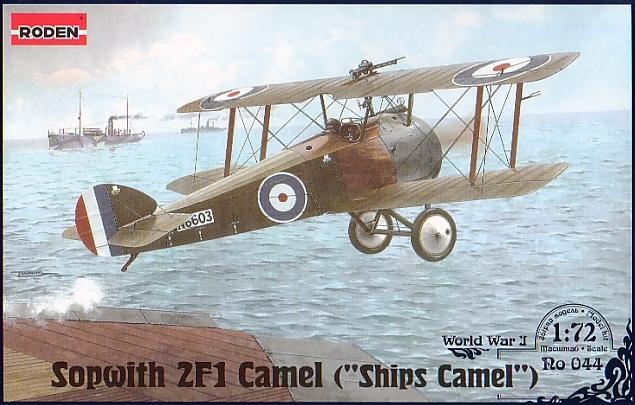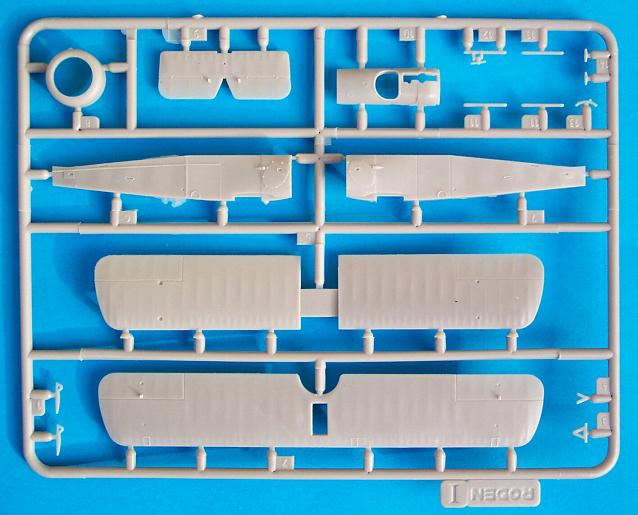|
Sopwith 2F1 Camel
“Ships Camel”

Roden 1/72
S
u m m a r y
|
| Catalogue Number: |
RD 0044 - Sopwith 2F1 Camel (“Ships
Camel”) |
| Scale: |
1/72 |
| Contents and Media: |
64 parts in injection moulded
plastic; markings for four aircraft |
| Price: |
USD$7.97 from Squadron.com
|
| Review Type: |
FirstLook |
| Advantages: |
Quality mouldings, acetate
windscreen, comprehensive parts and decals. |
| Disadvantages: |
Some outline and detail errors |
| Recommendation: |
Recommended |
Reviewed by Robert Baumgartner

Roden's 1/72
scale Sopwith 2F1 Camel is available online from Squadron.com
This is the first release of
Roden’s much anticipated Camel series.
It represents the Sopwith 2F1,
also known as the “Ships Camel” or “Split Camel”.
Towards the end of World War I,
this aircraft gave good service to British naval operations. Not only
did it bring down a few Zeppelins in combat, but it took its place in
the world’s first carrier strike force; the target being the Tondern
airship base.
Three plastic sprues confront
the modeller, these containing a total of 64 parts. Each item is crisply
moulded and carries the fine detail we have come to expect from Roden.

Click the thumbnails below to view larger images:
A portent of things to come is
revealed by the inclusion of three different propellers, three engines,
bombs, extra Lewis drums and two cowlings. More welcome additions to the
spares box.
The cockpit has a very good
representation of the internal structure moulded to the inner fuselage
halves. To this is added the fuel tank, seat, floor, control column,
rudder bar and instrument panel.
Two upper engine decks are
supplied, these being used to accommodate either the 130h.p.Clerget or
150 h.p. Bentley rotary engines. Three out of the four options use the
latter but the cowl Roden supplies for this has cooling slots that are
not appropriate for the offered options. As a consequence, an awkward
filling process results.
A study of the fuselage halves
reveals some unusual properties. Although the detail is sharp, some of
it is a little misguided. The starboard side horizontal lacing is very
much over scale and does not match its corresponding vertical
counterpart.
The point at which the fuselage
splits for stowage on this side is represented by an equally large
“plank”. Strange…as this is seen as a panel line on the port side. Both
this and the above problem are not too hard to fix but can be considered
a nuisance.
The wings a superbly moulded.
Not only are they razor sharp but also exhibit subtle rib detail and no
sign of warpage. The same holds true for the tail surfaces and it is
pleasing to see all control horns moulded in situ. For those that like
these items thinner, it is an easy task to whittle away at them in their
attached positions.
Struts and undercarriage are
commendably thin, and it’s good to see that Roden have included the
characteristic Rotherham wind driven pump.
Generally the kit scales well
but a cursory look at the parts did cause the raising of an eyebrow and
a scurry for contemporary photos. The tailplane outline is much too
square and needs desperate sanding. The main wingtips could also do with
a little revising of their shape.
The upper wing was in three
pieces on the original aircraft so it is a must that the modeller
scribes this missing detail on the kit. If you feel really brave, you
can also represent the underwing piquet rings and top wing eye brackets
for the lifting cables.
An acetate sheet is supplied for
the windscreen and this welcome addition will help keep this area
looking in scale.
Marking Options
Four options are catered for on
a very comprehensive decal sheet.
Sensibly the red centres for the
roundels are printed separately to avoid registration problems but this
hasn’t saved the rest of these items. Sadly my example had the white
outer circles mismatched with the inner blue ones.
Rudder and elevator stripes are
provided as well as the types typical stencilling.
The subjects presented are:
-
Sopwith 2F1 Camel,
N6603, HMS Pegasus, 1918
-
Sopwith 2F1 Camel,
N6602, HMS Furious, 1918
-
Sopwith 2F1 Camel,
N7149, Turnhouse Naval School, 1918
-
Sopwith 2F1 Camel,
N7120, HMS Queen Elizabeth, 1918
It is unusual to find this many
anomalies with a Roden kit. Admittedly the corrections are not above the
skill level of the average modeller but to have to do such work is
surprising.
The detail is up to the usual
standards set by this company and with a little extra work, an excellent
model should result.
Recommended
Thanks to
Squadron.com for the review
sample.
Review and Images Copyright © 2005 by
Robert Baumgartner
Page Created 04 August, 2005
Last updated 03 August, 2005
Back to HyperScale Main Page
Back to Reviews Page
|
Home | What's
New | Features
| Gallery |
Reviews | Reference
| Forum
| Search